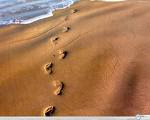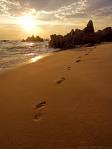The sesamoids are two pea-shaped bones located in the ball of the foot beneath the big toe joint.
Sesamoids help the big toe move normally and provide leverage when the big toe "pushes off" during walking and running. They also serve as a weight-bearing surface for the first metatarsal bone to absorb the weight placed on the ball of the foot when walking, running and jumping.
Sesamoid injuries can involve the bones, tendons, and/or surrounding tissue in the joint. They are often associated with activities requiring increased pressure on the ball of the foot, such as running, basketball, football, golf, tennis and ballet. In addition, people with high arches are at risk for developing sesamoid problems. Frequent wearing of high-heeled shoes can also be a contributing factor.
To diagnosis a sesamoid injury, the podiatrist will examine the foot, focusing on the big toe joint. The Doctor will press on the big toemove it up and down and may assess the patient's walking and evaluate the wear pattern on the patient's shoes. X-rays are ordered, and in some cases, advanced imaging studies may be ordered.
Non-surgical treatment for sesamoid injuries of the foot may include one or more of the following options, depending on the type of injury and degree of severity: Padding, strapping or taping: A pad may be placed in the shoe to cushion the inflamed sesamoid area. Immobiliztion: the foot may be placed in a cast or removable walking cast. Crutches may be used to prevent weight bearing. Oral medications: nonsteroidal anti-inflammatory drugs such as ibuprofen is helpful in reducing the pain. Physical therapy: this could be exercises, strengthening and ultrasound. Steroid injections: cortisone is injected into the joint to reduce inflammation. Orthotics: custom orthotics that fit into the shoe may be prescribed for long-term treatment of sesamoiditis to balance the pressure placed on the ball of the foot.
If the above treatment does not help then surgery may be required.
So if you are experiencing pain in the ball of your foot under the great toe give Dr. T. Vail a call for an appointment to see if this is the reason for your pain. 419-423-1888. On our website : http://www.vailfoot.com/ visit our online store and there are Dr. Jill's Dancer pads that will help to cushion the inflamed sesamoid bones.




